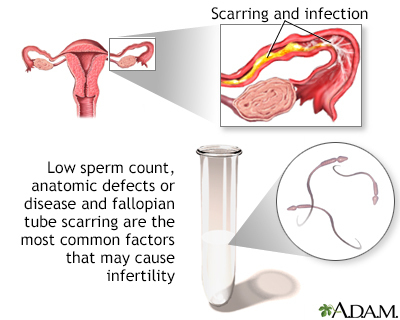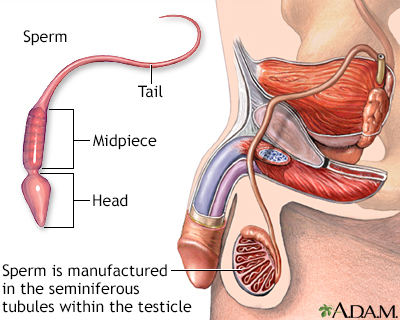Courtney and the Cancer She Never Planned For
Courtney has always been a planner, even as a child. Growing up in Gainesville, she produced pretend weddings for her sister and neighborhood friends, ensuring…

Update your location to show providers, locations, and services closest to you.
Infertility means you cannot get pregnant (conceive).
There are 2 types of infertility:
Inability to conceive; Unable to get pregnant
Many physical and emotional factors can cause infertility. It may be due to problems in the woman, man, or both.
FEMALE INFERTILITY
Female infertility may occur when:
Female infertility may be caused by:
MALE INFERTILITY
Male infertility may be due to:
Male infertility can be caused by:
Healthy couples under age 30 who have sex regularly will have about a 20% per month chance of getting pregnant each month.
A woman is most fertile in her early 20s. The chance a woman can get pregnant begins to decrease around age 35 (and especially after age 40). The age when fertility starts to decline varies from woman to woman.
Infertility problems and miscarriage rates increase significantly after 35 years of age. There are now options for early egg retrieval and storage for women in their 20's. This will help ensure a successful pregnancy if childbearing is delayed until after age 35. This is an expensive option. However, women who know they will need to delay childbearing may consider it.
Deciding when to get treated for infertility depends on your age. Health care providers suggest that women under 30 try to get pregnant on their own for 1 year before getting tested.
Women over 35 should try to get pregnant for 6 months. If it does not occur within that time, they should talk to their provider.
Infertility testing involves a medical history and physical exam for both partners.
Blood and imaging tests are most often needed. In women, these may include:
Tests in men may include:
Treatment depends on the cause of infertility. It may involve:
Couples can increase the chances of becoming pregnant each month by having sex at least every 2 days before and during ovulation.
Ovulation occurs about 2 weeks before the next menstrual cycle (period) starts. Therefore, if a woman gets her period every 28 days the couple should have sex at least every 2 days between the 10th and 18th day after her period starts.
Having sex before ovulation occurs is especially helpful.
Women who are under or overweight may increase their chances of becoming pregnant by getting to a healthier weight.
More information and support for people with infertility and their families can be found by joining a local support group. You can ask your provider to recommend local groups.
As many as 1 in 5 couples diagnosed with infertility eventually become pregnant without treatment.
Most couples with infertility become pregnant after treatment.
Contact your provider if you are not able to get pregnant.
Preventing STIs, such as gonorrhea and chlamydia, may reduce your risk of infertility.
Maintaining a healthy diet, weight, and lifestyle may increase your chance of getting pregnant and having a healthy pregnancy.
Avoiding the use of lubricants during sex may help improve sperm function.





Barak S, Gordon Baker HW. Clinical management of male infertility. In: Jameson JL, De Groot LJ, de Kretser DM, et al, eds. Endocrinology: Adult and Pediatric. 7th ed. Philadelphia, PA: Elsevier Saunders; 2016:chap 141.
Broekmans FJ, Fauser BCJM. Female infertility: evaluation and management. In: Jameson JL, De Groot LJ, de Kretser DM, et al, eds. Endocrinology: Adult and Pediatric. 7th ed. Philadelphia, PA: Elsevier Saunders; 2016:chap 132.
Catherino WH. Reproductive endocrinology and infertility. In: Goldman L, Schafer AI, eds. Goldman-Cecil Medicine. 26th ed. Philadelphia, PA: Elsevier; 2020:chap 223.
Lobo RA. Infertility: etiology, diagnostic evaluation, management, prognosis. In: Gershenson DM, Lentz GM, Valea FA, Lobo RA, eds. Comprehensive Gynecology. 8th ed. Philadelphia, PA: Elsevier; 2022:chap 40.
Practice Committee of the American Society for Reproductive Medicine. Fertility evaluation of infertile women: a committee opinion. Fertil Steril. 2021;116(5):1255-1265.PMID: 34607703. pubmed.ncbi.nlm.nih.gov/34607703/.
Practice Committee of the American Society for Reproductive Medicine. Diagnostic evaluation of the infertile male: a committee opinion. Fertil Steril. 2015;103(3):e18-e25. PMID: 25597249. pubmed.ncbi.nlm.nih.gov/25597249/.




Courtney has always been a planner, even as a child. Growing up in Gainesville, she produced pretend weddings for her sister and neighborhood friends, ensuring…

August 25, 2023
A popular artificial intelligence chatbot fell short of the standard expected of physicians when tested on common medical questions often posed by patients…
AI at UF, Department of Urology, +3 more

Trying to get pregnant can be an emotional rollercoaster for both women and men. It’s an issue for one in eight couples of childbearing age in the U.S. struggling with infertility, studies show....
Endometriosis is a disease with potentially troubling outcomes for women trying to get pregnant. The condition, in which tissue grows abnormally outside of the uterus, affects between 5 and 10...
Endometriosis is a disease with potentially troubling outcomes for women trying to get pregnant. The condition, in which tissue grows abnormally outside of the uterus, affects between 5 and 10...